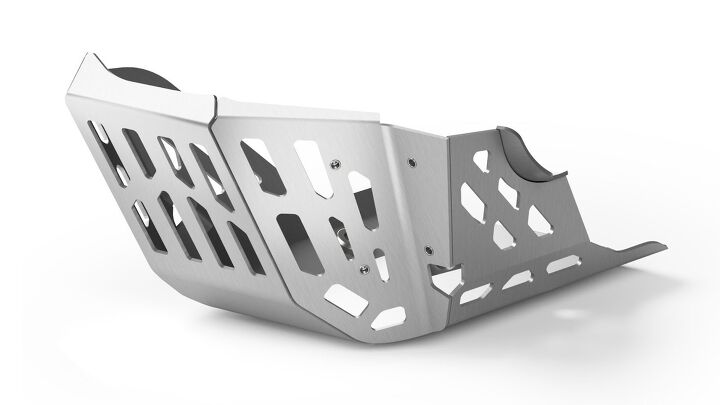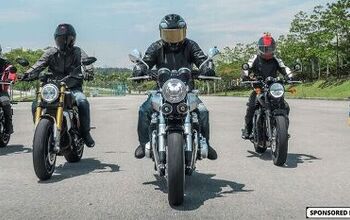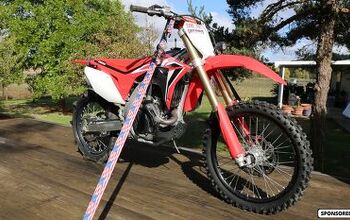Accessorizing Your Motorcycle

Making your bike “your own” is the buzzword of the century for manufacturers. Herein, a few words of wisdom for how to go about it.
Motorcycle.com is no fashion rag, but maybe the fashion maxim of “Accessorize, accessorize, accessorize!” has some merit here after all. That’s because changing the looks and capabilities of your bike can be just as important to a happy ride as is changing apparel for your work or social life. Just for instance, adding a taller or shorter seat tailors the bike to your proportions better, thereby improving ride comfort. Adding a windscreen, a USB adapter, and a tail bag turns it into a light tourer. Getting front and rear shop stands make cleaning and servicing the wheels way easier and more fun. And then, adding custom-style anodized parts adds a bit of bling that really stands out.
Motorcycle.com thanks Yamaha for sponsoring this new rider series.
Like, Why Accessorize?
The first question to ask yourself about accessorizing is – why me? Put simply, this challenges whether you want to change the functionality of the bike, the appearance – or both. Once that is figured out, then you just need to execute.
In our experience, there are three ways to accessorize a bike. One is to design and fabricate everything yourself, including brackets, stands, fenders, seats, and so forth. We’ve done most of this, and can report that fabrication is time consuming, that its learning process is fraught with failures, and that having the right tools and materials is essential. A second way is to buy generic accessories and hope they fit – ever hear of the old JC Whitney catalogs? – but really, that’s a lot like putting $100 on the roulette wheel in Sin City and just calling it red. And finally, there’s the path of least resistance (aka the smartest path?) – buying factory accessories, often called “Genuine” by manufacturers. Also, many online retailers allow you to search by specific model to find available parts.
The logic here is as simple as a 13mm combination wrench: When you buy factory parts and accessories, they’re designed for your exact model and should absolutely fit. They’re also warranted, just like your motorcycle. Bottom line, factory accessories are a whole lot easier – and faster, and possibly even safer – than making your own pieces or modifying generic parts.
The Funnel Narrows
It's worth noting here that due to emissions laws, it’s gotten harder for aftermarket parts and accessories makers to offer components that alter how the engine runs, including ignition, induction, fuel, and exhaust systems – especially for street models. This may explain why some custom builders choose earlier bikes to modify; tons of interesting pre- or early-emissions era components still exist, and may be easily found online, at swap meets, or through the buddy network.
Like it or not, emissions regulations are a reality, and they mean that bike manufacturers must thread the needle, figuratively of course, in choosing what accessories to offer. Just as an example, Yamaha sells Genuine Accessories for every type of machine, from Adventure Touring and Cross Country, to Supersport and Trail bikes. Digging further, these accessories are grouped into subsets as disparate as Electrical and Fenders, Performance and Protection, and Stands and Tools. In a quick search, we noted 566 accessories in all.
Extensive and Eclectic
A few fun items found: An aluminum skid plate for the Ténéré 700 that looks like it could survive a Mars landing in a meteorite field; a GYTR quick shifter for the MT-09 so you can channel Valentino Rossi at Mugello; a GYTR power tuner for the YZ250F motocross racer that lets you match power delivery to track conditions; and a pair of fiberglass V Star 1300 side bags so you can get outta town – and then stay gone as long as you want. Sounds good to us!
As alluded to above, using “genuine accessories” is code for “they’ll actually fit!” And they will (hopefully) come with installation instructions, either cryptic or clear. (Don’t worry, you can handle it either way.) Basically, though, factory accessories should be “bolt-on” components, which translates to: A) Remove the original part; and B) Install the new one. This renders the future possibility of offsetting the cost of the new parts by selling the (now unneeded) originals on Craigslist, FB Marketplace, or online. Sometimes, it’s surprising how much original parts cost over the counter…and what folks will pay for good “pre-owned” examples. It takes time though, so be forewarned.
Installation Day
Unlike in Independence Day, where cities get blown up by the alien mothership, we hope and surmise that with some advance planning, intelligent life forms present in your garage, and a dose of patience, the parts you’ve purchased for your bike will bolt right on. There are so many variations and possibilities to consider here, that it’s impossible to predict an outcome. But we have faith in you, and your newly acquired parts! Just one (okay, or several) words of advice: Take your time, read all directions at least twice, and attract talent better than you for your garage time. Three large pepperoni pizzas are a cheap payment compared to stripped cases, scratched chrome, and a dented gas tank.
A Financial Argument
If you’re going to modify or accessorize your bike, maybe first consider the financials. On the upside, if you buy “Genuine” accessories along with your new motorcycle, you may be able to roll them into the purchase contract. Captive retail lenders often allow for a generous amount above MSRP for accessories. If you choose this route, then, you’ll pay for the accessories at the same APR as the machine itself, rather than at rip-off credit-card rates. Which, as everyone not born on Pluto knows, will be a way better deal. Also, if you buy factory accessories when you purchase a new bike, they may carry the same warranty as the motorcycle (including if you buy an extended warranty), so you win again.
Become a Motorcycle.com insider. Get the latest motorcycle news first by subscribing to our newsletter here.

John L. Stein brings 30 years of both automotive and motorcycle experience, having written for AutoWeek, Car and Driver, Motor Trend, Sports Car International, Chevy Outdoors, Truck Trend, Cycle World, Motorcyclist, Adventure Travel, and Men’s Journal, just to name a few. His articles have been published in the US, England, Japan, Australia and France. His technical knowledge combined with his ability to understand and effectively communicate what a motorcycle is doing underneath him is an invaluable resource to the Motorcycle.com team.
More by John L. Stein
































Comments
Join the conversation
And here is the best part. When I add some "useful and practical" accessories, I hang onto my bike and keep it. The one I just sold was 20 years old after buying it new in 2003.
Strange how owners will accessorize a motorcycle and when there is nothing left to buy, they sell it and start all over again. And they do this over and over all the time. LOL
I added a Puig windscreen and their crash bars to my Kawasaki Vulcan S. The windscreen was easier than expected. The instructions for the crash bars were utterly incomprehensible. The latter ended up being installed by my dealer as I lost patience with it. The result was as expected and worth paying then for.